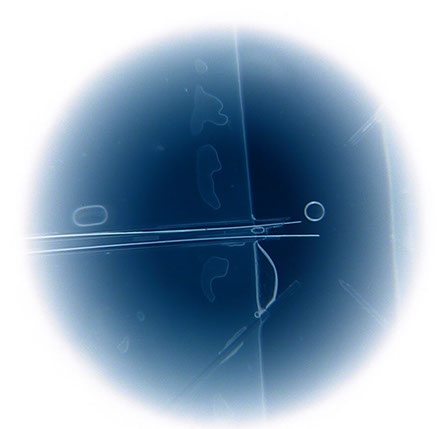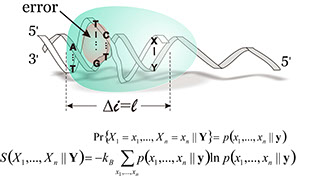

TECHNIQUES
HISTORY & GALLERY
Español
Molecular Biomachines
Efficient replication, transcription, packing or modification of nucleic acids is carried out by proteins that exploit the physical properties of these polynucleotide chains. Tension and torque applied by DNA interacting proteins may induce structural changes, unzip or unwind the two strands of the double helix. The single-molecule approach to the study of molecular biomachines leads naturally to the thermodynamic analysis of their mesoscopic context. At present, we study genetic information managing in replication and transcription as performed by polymerases, which are true molecular Maxwell’s demons with a 2-bit nanoprocessor.
Sketch of DNA replication with focus on genetic
information processing.

Optical Manipulation of Functional Nanostructures
Stringent control of stimulus-response phenomena in the nanoscale are demanded to understand the behavior of nanostructures, either biological or synthetic, in the cellular context. Some years ago, we demonstrated in vitro optical manipulation of individual centrosomes, which are complex organelles in higher eukaryotic cells. We explored their biological response to electric fields, pH and calcium concentration. Using this optical trapping approach, we are studying synthetic, functional nanoparticles with dynamic response to external stimuli in physiological media with the aim of tailoring biocompatible tools in Nanomedicine, biosensor technology and single-molecule biophysics.
Gold nanoparticles coated with pNIPAM, a thermoresponsive material, as observed by transmission electron microscopy.

Sketch of the optical nanomanipulación of these nanoparticles showing the temperature profile as a function of the laser trapping power.

Development of Biophysical Techniques for Intracellular Manipulation
The investigation of in vivo physics in the interior of biological cells constitutes an exciting field for the consequences to both biology and engineering in the nanoscale. We seek to understand the physical basis of key mesoscopic processes in biology, such as cell division and organization, with novel techniques able to tackle the interior of the cell.
Nucleic Acids
These biopolymers represent soft ‘hard drives’ that store and spread information. Nucleic acid physical properties have evolved in tune with the machinery that processes them, rendering these processes more efficient over the ages. We are currently focused on non-canonical nucleic acid structures, in particular we are studying G-quadruplexes, which are four-stranded structures in which G-rich sequences can self-assemble. DNA G-quadruplexes have been observed at telomere ends and in gene promoter regions. On the other hand, RNA G-quadruplexes form in mRNA or by the transcription of the telomeric DNA into the repeat-containing RNA (TERRA). G-quadruplexes seem to play a major structural and regulatory role in the chromosomal maintenance and in the control of gene expression. We use optical tweezers, AFM and molecular dynamics simulations to understand their mechanical stability.

Force-induced unfolding of long RNA constructions of GGGUUA repeats by optical tweezers.
Molecular Biomachines: Non-equilibrium and Information
Optical Manipulation of Functional Nanostructures
Development of Biophysical Techniques for Intracellular Manipulation
Mechano-chemistry of Nucleic Acids
Current Research
We are investigating biomolecules important for cell function and biocompatible nanoparticles that may be used in Nanomedicine. Inspired by the experiments, we also develop theory in mesoscopic systems.
Go to The Context
Universitat Politècnica de València Camino de Vera, s/n 46022 Valencia Dr. J. Ricardo Arias-Gonzalez

